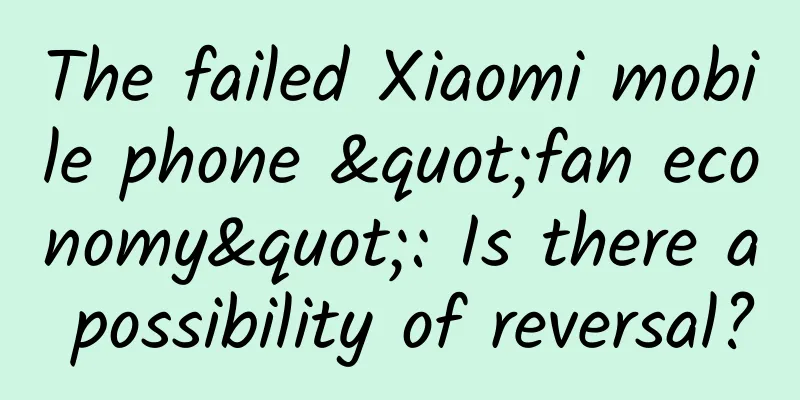The failed Xiaomi mobile phone "fan economy": Is there a possibility of reversal?

|
Written in front: If you are a star, there will be a day when you will be out of fashion. Xiaomi phones now seem to be caught in this embarrassing situation. Xiaomi mobile phone, which relies on "hunger marketing" to play with "fan economy", has reached a development turning point after several years of rapid growth. Its shipments have peaked and are falling back, showing an increasingly steep downward trend. So, will the once “idol” Xiaomi smartphone never recover from this setback? Or will it have a chance to become a “real powerhouse” and regain its momentum? I guess even Lei Jun himself can’t understand why Xiaomi phones suddenly entered a downward channel. Recently, data released by market research firm IDC showed that Xiaomi's smartphone sales in the second quarter of this year were approximately 10.5 million units, a sharp drop from 17.1 million units in the same period last year, a decrease of 38.4%. This is the second consecutive quarter that Xiaomi's sales have fallen since 2016 and the decline has widened. IDC data shows that Xiaomi shipped 9.2 million smartphones in the first quarter, down 32% year-on-year. In fact, the decline of Xiaomi mobile phones had already become apparent in 2015. In 2015, Xiaomi shipped more than 70 million mobile phones, while the previous internal target was 80 to 100 million units, which means that there was a gap of 12% to 30% in the sales plan that was not completed. So why did Xiaomi, which was born for enthusiasts, fall into a downward trend after creating miracles in Internet mobile phone sales for several consecutive years? Is there still a chance for Xiaomi to rebound from the bottom? Looking back at the development history of Xiaomi mobile phones, its phased success was due to the "fan economy", and its current "difficult to reverse decline" is also due to the "fan economy". Simply put, Xiaomi mobile phones, which focus on the "fan economy", will naturally enter a stage of large-scale "fan loss" after failing to meet the needs of fans. How the “fan economy” works: Focusing on marketing and neglecting patents brings “obstacles” to development It is undeniable that over-emphasizing "fan economy" and ignoring patent risks were the first hurdles Xiaomi mobile phones encountered. In 2014, when Xiaomi was at the peak of its development, it stepped up its internationalization efforts and entered the Indian market. In December of that year, Xiaomi announced that its shipments in India exceeded 1 million in just 6 months. It can be said that from a strategic perspective, Xiaomi's expansion into overseas markets at a time when its brand premium is the highest is worthy of recognition. However, although Xiaomi has long wanted to go international, it is not actually ready. On December 11, 2014, Xiaomi was sued by Ericsson in the Delhi High Court in India for allegedly infringing eight patents owned by Ericsson, including ARM, EDGE, 3G and other related technologies. At that time, the court agreed to Ericsson's application for a temporary injunction that "prohibited Xiaomi from selling, promoting, manufacturing and importing related products suspected of infringing Ericsson's patents in the Indian market, and required Xiaomi and its local Indian e-commerce partner Flipkart to temporarily stop selling the patented products involved in the case sued by Ericsson." Subsequently, Xiaomi obtained a license to continue selling mobile phones using Qualcomm chips on the condition of "prepaying 100 Indian rupees per device and depositing it in court", while mobile phones equipped with MediaTek chips are still "banned from sale". Obviously, the sudden "patent sniping" brought a huge shock to Xiaomi. This shock not only directly affected the sales of Xiaomi mobile phones in India, but also brought an impact on Xiaomi's development strategy. In fact, long before Xiaomi was ready to enter the Indian market, Ericsson had tried to reach a patent licensing cooperation with Xiaomi. However, Xiaomi did not respond positively at that time for various reasons. This strategy of "focusing on marketing and neglecting patents" has planted the "seeds" of crisis for Xiaomi mobile phones early on. The myth of "online direct sales": Xiaomi missed the best time to deploy offline channels In the early days of Xiaomi mobile phones, one of the core elements of its marketing was that there were no "middlemen", that is, "traditional channels", and the manufacturer directly contacted the users, so the final sales cost was low. This made many early users believe that the mobile phones they purchased through Xiaomi’s official website should be the most cost-effective mobile phones on the market at that time. In addition, Xiaomi’s early “hunger marketing” model and word-of-mouth marketing models such as Weibo have allowed Xiaomi to realize the benefits of the “direct sales” or “light channel” model. However, the success of the "fan economy" or "online direct sales" model also became the biggest "constraint" on Xiaomi's mobile phone sales. During the heyday of Xiaomi mobile phones, many people suggested that Xiaomi should pay more attention to the layout of offline displays and sales channels. However, Xiaomi and Lei Jun did not listen to this well-intentioned advice at the time. On the one hand, "online direct sales" was given the flavor of "Internet +" at the time, and seemed to represent advanced productivity or sales model. On the other hand, Xiaomi expanded its JD.com and Tmall flagship stores from its official website, which on the surface also broadened its sales channels. But the problem is that Xiaomi overestimated the Internet usage capabilities of many users in second-, third- and fourth-tier cities, and also overestimated the depth and breadth of penetration of "Internet sales." As a result, after Huawei, OPPO and other smartphone brands filled their "marketing shortcomings", they quickly achieved a surge in sales by relying on their widely distributed offline channels, while Xiaomi entered a downward channel after its Internet sales peaked. Missing the "user pain point": Xiaomi is no longer a "hot product" because it focuses less on experience and more on monetization What are the pain points of smartphones? In the early days, when most users were still using non-smartphones, the biggest user pain point or selling point of smartphones was their "intelligence", which allowed them to use or run various applications or tools. In its early stages, Xiaomi made many innovations and attempts in terms of system and user experience by benchmarking against Apple, such as address book contact search, etc. Coupled with its low price, Xiaomi quickly became a "hot product" among the technical crowd, and with the help of word-of-mouth effect among the technical crowd, it spread to a wider audience. However, as more and more people use Android phones, user pain points such as "slow system" and "too short standby time" have become increasingly prominent. Especially the problem of "standby time", but Xiaomi series of mobile phones have not been able to solve this user pain point well. However, despite its rise to fame thanks to its fans, Xiaomi’s mobile phone products are gradually moving away from the pain points of its fans. When solving the "short standby time" problem, the strategy adopted by Xiaomi series of mobile phones is to continuously increase battery capacity and optimize the system to reduce losses, but it did not get involved in "fast charging technology" early on. On the contrary, OPPO, which was not optimistic before, was the first to achieve a breakthrough in fast charging technology, solving the pain points of users, and using advertising to spread and shape the advantages and highlights of its mobile phones on a larger scale with the slogan "charge for five minutes, talk for two hours". In addition, with the continuous increase in sales of Xiaomi mobile phones and profit considerations, Xiaomi’s early so-called "cost pricing" is no longer mentioned. At the same time, in order to expand its revenue sources, Xiaomi's mobile phone system has added many advertising or commercial promotion entrances to screen savers, browsers, etc., which have a certain negative impact on user experience. Simply put, Xiaomi's neglect of business risks, lack of offline channels, and slow response to user pain points, coupled with the short smartphone replacement cycle of users, has led to the business model of Xiaomi based on fan economy, which is bound to fall into a sales decline channel after experiencing "fan loss". Whether to “reverse the downward trend” or not: The key lies in whether Xiaomi mobile phones will be popular again So, will Xiaomi's smartphone industry never recover from this setback? Or is there a chance that it will be revived? In terms of patents, in order to address its existing "shortcomings", Xiaomi has purchased a large number of patents from various giants in the past year. On October 23, 2015, Xiaomi acquired 31 wireless communication patents from Broadcom. On February 4, 2016, Xiaomi purchased 332 U.S. patents from American chip giant Intel. On June 1, 2016, Xiaomi purchased another 1,500 patents from Microsoft. According to media reports, Xiaomi International Vice President Hugo Barra said that smartphones will soon be available in the United States. Obviously, officially selling smartphones in the United States will be a shot in the arm for Xiaomi's mobile phone brand and development. However, it is still unknown whether it can reverse the downward trend in sales. In terms of marketing, Xiaomi mobile phones, which focus on "fan economy", have never or rarely advertised, but have also begun to increase their advertising efforts. By introducing celebrity endorsements and billboard advertisements, Xiaomi will increase its brand influence on non-Internet users. In the future, it is not ruled out that Xiaomi will follow the example of OPPO and other mobile phones and increase cooperation with popular TV programs in order to expand user coverage in second-, third- and fourth-tier cities, and continue to improve Xiaomi's sales network or channel layout. Of course, whether Xiaomi mobile phone can regain its previous glory depends not only on its product improvement efforts, but also on the improvement of user experience. Of course, it also depends on industry trends, such as 5G or the Internet of Things, because a pig that takes off at the wind's vent can only wait for the next wind to come if it wants to take off again. As a winner of Toutiao's Qingyun Plan and Baijiahao's Bai+ Plan, the 2019 Baidu Digital Author of the Year, the Baijiahao's Most Popular Author in the Technology Field, the 2019 Sogou Technology and Culture Author, and the 2021 Baijiahao Quarterly Influential Creator, he has won many awards, including the 2013 Sohu Best Industry Media Person, the 2015 China New Media Entrepreneurship Competition Beijing Third Place, the 2015 Guangmang Experience Award, the 2015 China New Media Entrepreneurship Competition Finals Third Place, and the 2018 Baidu Dynamic Annual Powerful Celebrity. |
>>: What Sony didn't tell you about HDR
Recommend
Are the “edited” vegetables delicious?
The cover image is a copyrighted image. Reprintin...
SAIC Passenger Vehicle’s new energy vehicle sales in October reached 13,646 units, a year-on-year increase of 196.3%!
Recently, the State Council officially released t...
Using large leather bags to put out fires, building tall buildings to watch for fires... How cool were the ancients' "fire prevention plans"?
Summer heat It is a high incidence period for var...
AARRR traffic funnel model|Himalaya FM analysis report!
This article uses the AARRR traffic funnel model ...
The day after tomorrow, a mysterious "X" will appear on the moon's surface...
Original title: "A date with the starry sky丨...
The calm before the outbreak? Comprehensive thinking about "Mini Programs"
Since WeChat announced the upcoming release of Mi...
Collection | 20 niche and practical new media tools
Tool quotient, which is the ability to use variou...
Perfect Diary’s private domain strategy!
In the past two years, as private domain business...
What is the nose under the bow of a boat for? Without it, the boat can't go fast.
Have you ever noticed those ocean-going cargo shi...
Why does Musk want to take Tesla private? Three reasons why Musk wants to "sell" the company
On the morning of August 8, Beijing time, Tesla C...
Chatting about technology: Predicting the six major technology trends of mobile phones in 2015
2014 has gone far away from us. In the past year,...
Bao Juncheng: ATA All-round Literacy - Reading Chinese Stories (A)
A unique learning dimension: explaining Chinese s...
How to take the "special medicine" when you are infected with influenza B? 10 questions and 10 answers from pharmaceutical experts
Recently, influenza (hereinafter referred to as f...
Comparison between Flutter and Android native WebView
Preface Since Google launched the flutter cross-p...









